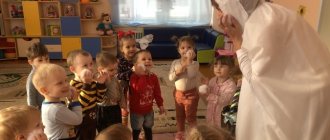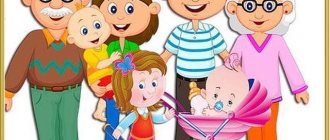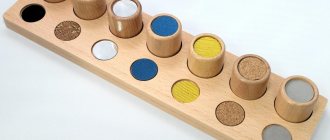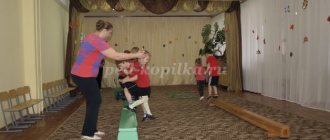Walking
During the games presented in this section, children learn to walk in a certain direction, on an inclined plane, change the method, speed and direction of movement, maintain a certain rhythm of movement, overcome obstacles, coordinate their movements, coordinate them with the movements of other children, etc.
"Stand up, baby, one more time"
This game is good to play with children who are just learning to walk. The game is played with one child.
The teacher says to the child: “Sasha (child’s name), your legs probably want to go for a walk, let’s go for a walk!” He takes the baby by the arms and helps him stand up, saying:
The teacher leads the child by the hand or gives him the opportunity to walk around on his own, encourages him and praises him for his success.
"Big feet"
The teacher asks the child: “Do you want to take a walk along the path?” – takes him by the hand (or from behind under the armpits) and leads him out, – says the teacher, showing him how to take long steps. He helps the baby, saying:
The teacher continues: “And now our legs have become very small. How can they run?” Together with the child, he runs at the pace that the child can do, and continues to read the poem:
When the child remembers the order of actions, they can be combined by reading the entire poem and changing the tempo of movements.
"We walk in a line"
Children stand in a line and take each other by the shoulders (or belt). The teacher leads a line through the group in different directions and says: “This is the kind of string we have (snake, ribbon).” The “rope” can be “twisted” into a spiral (you will get a ball), then untwisted again and move on. The “snake” can go around obstacles encountered along the way (table, chairs, modules, etc.).
"Checkbox"
Children form a circle. The teacher asks one child to stand in the center of the circle and take a flag.
An adult leads the children in a circle and reads a poem:
The named child goes to the center of the circle. The presenter gives him the flag and stands in a circle.
The game continues until each child is in the center of the circle.
"Let's wave the flags"
This game is a continuation of the game "Flag". The teacher takes several flags (according to the number of children participating in the game) and says:
The teacher hands out flags to the kids: “Take, Olya, the flag! Take the flag, Nastya!” The adult keeps one flag for himself.
Then the children begin to move in a circle, repeating the movements of the teacher: they raise the flag above their heads, wave it, extend their hand with the flag to the side, lower it down, transfer the flag to the other hand, etc. The adult accompanies all movements with the words: “Waving the flag! The flag is down! Moved the flag to another pen,” etc.
It is advisable to play this game with music (march).
The game can be diversified by asking children to wave ribbons and handkerchiefs.
“Take a drop in your palm”
The teacher puts a toy bird and a bowl on the table, calls several children and says: “Look, there is a bird sitting on the table, she is thirsty, but there is no water in her bowl. Let's bring her some water in our palms. I will pour droplets of water into your palms, and you take them to the table and pour them into a bowl.”
The teacher shows the kids how to fold their palms, pressing their fingers together to prevent water from spilling. Then the teacher drips from a pipette or pours a few drops of water onto his palm and onto the children’s palms and says: “Walk carefully so as not to spill the water.” The kids, together with an adult, come up to the table and take turns pouring water into a bowl. The bird “drinks” some water and “thanks” the children.
In the same way, you can carry feathers, leaves, small balls, etc. in your palm (two palms).
"Train"
The teacher suggests to the kids: “Let me be the train, and you the carriages. Stand one behind the other, like this.” He shows how to wrap your arms around a child standing in front of you (or put your hands on his shoulders, grab his skirt, belt, strap). Then the teacher begins to slowly move around the group, reading the poem:
The teacher repeats the poem several times. Gradually, the pace of the poem and, accordingly, the movement of the “train” accelerates, the direction of movement changes.
Next time you play with your children, you can read another poem:
Children repeat onomatopoeia after the teacher: “too-too”, “too-too”, “chug-too”.
The game can be made more difficult. The teacher places long slats on the floor - “rails”. Children stand one after another. The child standing in front holds a flag, he represents a steam locomotive. At the teacher’s signal: “The train is leaving,” the kids walk between the slats. At the signal: “The train is approaching the station,” they stop.
"Elephants and Mice"
The teacher suggests to the kids: “Let's play with mice. Mice are small, their legs are also small. The mice run fast, but very quietly, you can hardly hear them.” The adult shows how the mouse silently moves in small, quick steps and encourages the children to imitate him.
After a while, the teacher stops and says to the children: “Mice, stop! Do you hear someone stomping loudly? It's an elephant coming."
The teacher begins to stomp, saying in a low voice: “Top, stomp.” The teacher explains to the children: “Elephants are big and their legs are big. Elephants walk slowly, with long strides, like this. Let's walk like elephants." An adult walks around the group with the children, saying ri.
In the future, the game can be complicated by asking the kids to change the pace of movement on command (“Now you are mice, and now you are elephants”), or by dividing the children (at their request) into two groups (elephants and mice), asking them to take turns pretending to be mice and elephants.
"Reach the bunny"
The teacher makes a path from oilcloth (width 25-30 cm, length 2-3 m) and places it on the floor. At one end of the path he sits a bunny and says to the children: “Look, there is a bunny sitting here. He is sad alone, he wants the children to pet him. To do this you need to walk along this path, like this.” (Shows.)
Children take turns walking along the path and petting the bunny. The teacher helps the kids keep the order and not go beyond the edge of the path.
The game can be complicated by drawing a line on the floor (asphalt or sand) or placing a cord. For older children, the path can be made winding.
"Let's go to the forest"
The teacher puts a path on the floor and says: “This is a path in the forest. Let's take a walk along it." Walking along the path, he shows the children how to walk at a normal pace, raising their knees high, on their toes, and on their heels. At the same time, the adult plays out the movements, for example: “We walk through the tall grass, raise our knees high, like this” or “Now we walk carefully, on our toes, so that the wolf doesn’t hear.”
"Heels, toes"
The teacher invites the children to stand in a circle. Then he says: “I have a bell and a tambourine. When I ring the bell, we'll walk on our toes, like this. And when I knock on the tambourine, we will walk on our heels, like this. When the bell and tambourine are silent, we will walk at a normal pace, like this. Listen carefully and watch me go.”
"We're going up the stairs"
The teacher places a ladder on the floor and invites the children to first walk along it, stepping over the rungs, and then stepping on the rungs.
First, an adult helps each child, leading him by the hand, and then walks next to him, securing the baby.
"On the Bridge"
The teacher draws two parallel lines (or places two cords) and tells the kids: “This is a stream. We need to cross to the other side. Let's build a bridge." The teacher “builds a bridge across the stream” (places a gymnastic bench 10-12 cm high) and explains: “We can use this bridge to cross the stream. You have to walk carefully so as not to fall into the stream and get your feet wet.”
Children take turns walking along the bench, first holding the teacher’s hand, and then on their own.
"On a smooth path"
The teacher draws or lays out three paths on the floor, and at the end of each of them he places a hoop.
The teacher takes two kids by the hands and leads them along the paths (the teacher walks along the middle path), reading the poem:
When the adult and the children reach the end of the paths, they sit down in the hoops with the words “thump into the hole.”
Subsequently, the game becomes more difficult. The teacher places two long slats or a track (1 m long) on the floor. At the end of the path he places a gymnastics bench, behind it are small cubes, and behind the cubes he places a hoop. The teacher suggests to the children: “Let’s first walk along a flat path, then along a bridge, then over pebbles, and then jump into a hole. Like this". He reads a poem and at the same time shows the children how to overcome obstacles:
After the words “And bang into the hole!” The teacher squats down in the hoop.
The teacher reads the poem again, and the children take turns overcoming obstacles.
"Find a toy"
The teacher makes a winding or straight path with obstacles (bridges of different heights (gymnastic benches), cubes (small for stepping, large for climbing), etc.). At the end of the path, he plants a toy and covers it with a scarf.
The teacher reads a poem:
The teacher shows the kids how to walk along the path. Children take turns approaching the house, finding a toy and calling it. Each time the adult hides a new toy.
"Naughty Kitten"
The teacher places a toy kitten on the crossbar of the gymnastics wall and tells the children: “Guys, look, the kitten climbed onto the ladder and cannot come down. Let's help him."
The teacher puts a crossbar against the wall and asks the kids: “Who wants to remove the kitten? Kostya, try it. Walk across the bridge and take off the kitten.” The baby climbs the inclined plane, takes off the kitten, goes down and gives the toy to the teacher.
The adult puts the kitten on the wall again and says: “What a naughty kitten, he climbed up the ladder again! Who wants to take it off now?”
In this way, the teacher encourages all children to go up and down the inclined plane. Next time you can invite the children to crawl along it.
"The toys got lost"
The teacher places toys on the mat (according to the number of children participating in the game) and places various obstacles: for the youngest children - 2-3 obstacles, for older children - 4-5 obstacles. These can be ribbed paths, bridges, rollers, cubes, gates, tunnels, etc.
The teacher says to the children: “Look, the little animals (dolls) got lost in the forest. They gathered in a clearing and cannot find their way home. Let's help them. First you need to walk along the bridge (bench) across the river, then climb over the slide (roller), and then climb through the gate.”
Each child goes through obstacles, takes a toy and comes back.
The game can be diversified by making several clearings and paths with different obstacles. Depending on the type of obstacles, children perform a wide variety of movements: walk in small and large steps, jump over, step over, climb over, crawl up, etc.
"Occupy your house"
The teacher places “houses” (rugs, pieces of fabric) in a circle and tells the children: “Let you be animals. Who wants to be who? Let you, Vanya, be a bunny, you, Verochka, a frog... Now choose your own houses.” Children choose houses and sit on their mats.
The teacher explains: “When the music sounds, the little animals run out of the houses and start dancing, jumping, and playing. When the music stops, everyone returns to their houses."
Music is playing, children are dancing. At the end of the music, the kids take their places in the houses.
The game is repeated several times.
The game can be varied. For example, sit children on chairs or modular cubes, and place a large animal toy next to each of them. While the children dance, portraying their character, the teacher moves the toys. At the end of the melody, the teacher says: “It’s raining, run to the houses!” Kids find their houses based on the toy.





